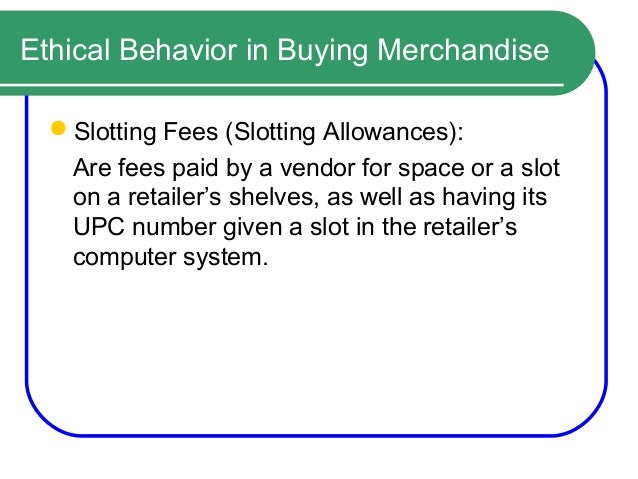A Slotting Fee Is A Payment That A
Posted By admin On 13/04/22


However, slotting fees are a payment that must be borne by all manufacturers. Competition for shelf space that leads to slotting may raise the cost of obtaining retail distribution, but it does so for everyone. Small manufacturers complain that they can't afford the slotting fees, which can run up to $25,000 per item per chain, depending on the number of stores and the appeal of the product. Slotting/listing fees: Slotting fees (or listing fee) is the amount of money a manufacturer pays a retailer to appear on the shelves. This transaction typically takes place after a range review process once the retailer is convinced about a product’s potential to generates sales and profit. Slotting fees average $1500 per store per SKU.
Slotting allowances refer to fees that suppliers pay for some type of preferential treatment from their distributors. There are a number of benefits that suppliers can receive from paying a slotting allowance, such as eye-level shelf placement of their products or the opportunity to introduce new ones. This practice is widely used in the grocery store industry. The need for these fees is supported by the risks and costs that are associated with stocking a store's shelves and replacing failed products with new products.
A Slotting Fee Is A Payment That A Dependent

A Slotting Fee Is A Payment That A Firm
Consumers tend to be most familiar with the practice of distributors purchasing products for their stores from various suppliers. Many are unaware that slotting allowances refer to a practice where suppliers pay the distributors to take some type of action. The prevalence of this practice greatly varies. Some distributors may require certain suppliers to make these payments or may require these fees for certain products. In other instances, suppliers may offer to pay slotting allowances to motivate a store to invest in a new product, to place a product in a prime location on the shelves, or to motivate a distributor not to drop a product from its stock.
The amount paid for slotting allowances also varies. Instead of decisions being made on an industry-wide basis, fees are often negotiated on a case-by-case basis. Different suppliers may be charged different fees, and it is even possible that one supplier may be subject to different fees for different items.

Grocery stores tend to operate differently than many other retail establishments, which operate on consignment. On the contrary, stocking grocery stores involves substantially greater risks because store owners purchase their merchandise outright. Any merchandise that does not sell or that must be deeply discounted results in losses for the grocery store owner. Annual product failure rates are generally high, supporting the need for slotting allowances in this industry.
These allowances allow stores to cover their costs. In addition to helping to compensate for the financial losses, the fees paid by suppliers also help to cover other categories of expenses, such as the costs of setting up displays and applying labor to remove unsold products from the shelves. Other costs associated with acquiring, selling, or replacing a product include warehousing, programming new items into vendor systems, and producing new shelf labels.
There are debates about the fairness of slotting allowances. It is commonly argued that this practice is anti-competitive because large suppliers have an obvious advantage. Some small suppliers cannot afford to pay these fees at all. This may keep their products out of certain stores or may prevent them from ever receiving preferential placement on the shelves.